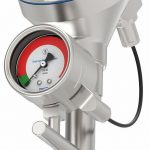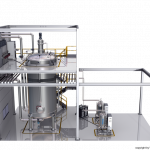The damage itself was only minor. Yet the indirect damage that ensued for vaccine manufacturers ended up costing millions. What actually happened was this: the company ships a finished active ingredient from the manufacturing plant to various other sites, where it is filled into injection vials. The mobile tanks for this purpose are sterilised upfront as a routine measure to ensure the necessary product purity. In two instances, however, the diaphragms of the diaphragm seal systems installed in these tanks for monitoring the pressure were so worn out following a filling operation that transmission fluid later leaked out and got into the tank. In both cases, the batch had to be destroyed.
Another loss on this scale would have been disastrous. The vaccine manufacturer reacted to the incident by immediately setting out in search of a pressure measurement solution that would reliably prevent such damage from reoccurring.
When electronic measuring instruments have to be connected to sterile processes, diaphragm seals are the only realistic option. Thanks to the flush diaphragm, which transmits the pressure via a fluid, they are more robust and easier to clean compared to conventional processing scenarios. On the other hand, if aggressive cleaning or similar agents are used, corrosion – and hence damage to the sensitive measuring element – cannot be completely ruled out. A rupture will inevitably result in leakage of the transmission fluid.
Self-monitoring diaphragm seal system
It was against this background that Wika developed the diaphragm seal system with diaphragm monitoring. This solution works with two diaphragms arranged one on top of the other. The space between them is evacuated and the vacuum is monitored with a pressure switch. If the process-side diaphragm ruptures, the vacuum is balanced. The monitoring device responds to the change in pressure and immediately sends a damage message. Meanwhile, the second diaphragm seals the process off from the environment reliably, so that the measuring instrument can continue recording the pressure until such time as the damage is repaired. The system precisely matched what the vaccine manufacturer was looking for and so all critical measuring points where diaphragm seals and transmitters are needed were provided with a self-monitoring arrangement.
Wika now launched the next generation of the monitoring solution. The DMSU21SA diaphragm seal system with process transmitter and diaphragm monitoring can be incorporated into digital structures using the Hart 7 protocol. This feature fits the device for industrial transformation and has also had functional impacts on the system’s further development.
The two main components of the predecessor model – the diaphragm seal plus measuring instrument and the diaphragm monitoring module – must be considered and assessed separately from one another. They each operate independently and the measuring instrument and the monitoring module both have their own signal output.
Emphasis on digitisation
The DMSU21SA is different: it is designed as an integrated system and has EHEDG, 3A and IECEx approval in this form. In addition to process pressure data or the sensor temperature and status, its process transmitter now also supplies information on the diaphragm status. It monitors the switch contact of the diaphragm monitoring element and outputs an alarm signal via the Hart protocol if a failure is detected. The setpoint must previously have been reached for a minimum of 1.5 s. This setting prevents unwanted alarms due to shocks or vibration.
The emphasis on digitisation means the diaphragm seal system only communicates via one output. It can be got up and running fast thanks to the plug & play principle. It is a simple matter to integrate it into an existing Hart environment. There is no need to lay a second cable harness as there is for the first system generation’s monitoring function. The plant reassessment that is sometimes stipulated when an additional, independent measuring component is built in can likewise be dispensed with.
Suitable for analogue brownfield plants
The DMSU21A is also potentially suitable for analogue brownfield plants for this reason. The transmitter’s electronics generally work with a 4…20 mA signal, which is simultaneously the basis for Hart. In the version without the communication protocol, status information in case of anomalies is output via a residual current, diaphragm monitoring included. The current is defined as 3.5 or 21.5 mA. If an error message appears, the user can determine the concrete cause on site after stopping the process, safe in the knowledge that its integrity was maintained up until the moment it was interrupted.
Self-monitoring instruments make processes more reliable and mitigate the consequences of failures to an acceptable level. The diaphragm monitoring module tells users the exact second when a process-side measuring element was damaged. They can then take appropriate counteraction, for instance by closing the feed valve or diverting the batch into a buffer tank. And if continued use of the product is deemed to be too risky even though the process was kept closed by the measuring system, the amount wasted can at least be restricted to a minimum.
Without a monitoring function of this kind, users can only guess at when the damage to the diaphragm occurred and the product was contaminated by the transmission fluid. If there is any doubt about this, they may have to go all the way back to the last maintenance interval. In spite of this, they are frequently left with no alternative but to destroy the complete batch if they want to rule out every conceivable risk. Since such plants normally operate 24 hours a day, it is not uncommon for large batches to be affected, so that the financial loss can easily run into seven figures.
Online search: WikaP2








